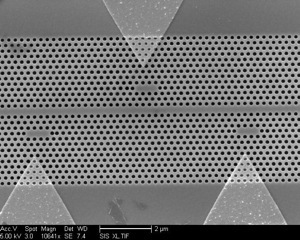The University of Vermont
Physics Department


The University of Vermont
Physics Department
Opals And Photonic Crystals
Text


This is a scanning electron microscope image of a manmade photonic crystal. The periodic arrangement of the holes in the material controls the movement of light within the crystal. Each hole is about 200 nm in diameter. A photonic crystal's highly ordered and repetitive structure affects the way light moves through it. Similar periodic arrangements are found in nature—for example, in precious opals and in the wings of the Blue Morpho butterfly. Andrei Faraon, Stanford University
An opal is an example of a naturally occurring photonic crystal. When an opal is observed, a variety of colors are seen due to the structure of the silica which compose the opal. Within an opal, the silica is essentially arranged as small spheres in a closely packed, regular arrangement such as the one below. The spacing between these spheres of silica is approximately 150 to 300 nanometers, approximately have the wavelength of visible light. Due to this spacing, light can interfere and diffract as it passes through the structure. The colors which are observed are due to the angle of observation with respect to the structure of the opal. This means that as the opal is turned, the same spot may take on different colors depending on how light interacts with the structure.
The main process at play in the generation of color within an opal is diffraction. As light enters the structure, it may interact with a silica sphere or it may pass through more of the structure prior to interacting with a silica sphere. For example, in the image below, the two layers could be silica spheres. As light is incident on the structure, some of the light interacts with a sphere on the topmost layer while other light passes through and interacts with the second layer. As the light is scattered off of the two spheres, the light which travels to the second layer must travel a farther distance to exit the structure. This allows interference to occur with light exiting the photonic crystal after scattering off of different layers. The light exits the crystal out of phase and interferes with itself. This diffraction process generates a variety of color within opals.